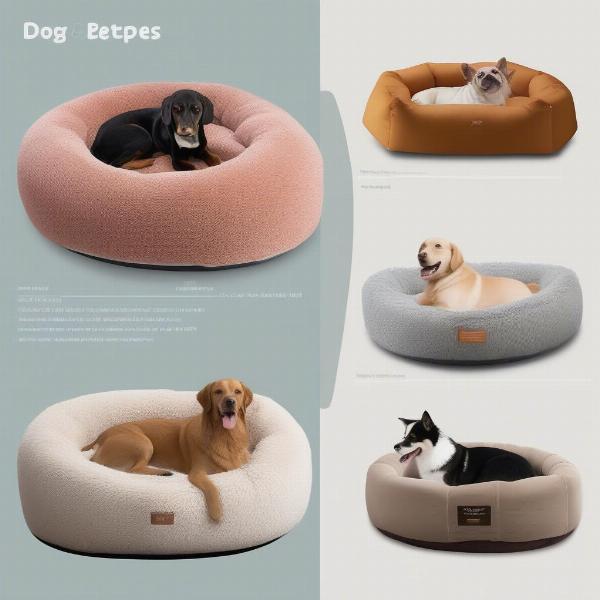Finding the right indoor dog bed can significantly impact your furry friend’s comfort and overall well-being. A comfortable dog bed isn’t just a luxury; it’s a necessity that provides a safe, secure, and relaxing space for your canine companion. From orthopedic support for older dogs to plush comfort for puppies, choosing the perfect indoor dog bed requires careful consideration of your dog’s breed, size, age, sleeping habits, and any existing health conditions.
A good indoor dog bed offers more than just a place to sleep. It provides a sense of security, helps regulate body temperature, and reduces pressure on joints, promoting better sleep and overall health. This guide will cover everything you need to know to make an informed decision, ensuring your dog gets the perfect sanctuary for a good night’s rest.
Understanding Your Dog’s Needs
Before diving into the world of indoor dog beds, take some time to understand your dog’s individual needs. Consider their size, age, sleeping habits, and any health concerns.
Size and Sleeping Style
Does your dog like to stretch out or curl up in a ball? Do they sleep on their side, back, or stomach? A larger dog will require a more spacious bed, while a smaller dog might prefer a cozy, enclosed space.
Age and Health
Older dogs or those with joint issues will benefit from orthopedic beds designed to provide extra support and cushioning. Puppies, on the other hand, might need a more durable and chew-proof bed.
Material and Cleaning
Consider the materials used in the bed. Some dogs are allergic to certain fabrics. Choose a bed with a removable, washable cover for easy cleaning and hygiene.
Types of Indoor Dog Beds
There’s a wide variety of indoor dog beds available, each designed to cater to different needs and preferences.
Orthopedic Beds
These beds are ideal for senior dogs or those with arthritis or hip dysplasia. They provide excellent support and cushioning, helping to alleviate joint pain and improve mobility. is 3 dogs too many
Plush Beds
These soft and cozy beds are perfect for dogs who love to burrow and snuggle. They are often made with faux fur or other soft materials, creating a warm and inviting sleeping space.
Nest Beds
These round or oval beds have raised sides, creating a sense of security and comfort. They are particularly suitable for small dogs who like to curl up.
Mattress Beds
These simple and versatile beds are a good option for dogs of all sizes and ages. They offer a flat, comfortable surface for sleeping.  Different Types of Indoor Dog Beds
Different Types of Indoor Dog Beds
Cave Beds
These enclosed beds provide a sense of security and privacy, making them ideal for anxious or shy dogs. They offer a warm and cozy den-like environment. outside dog bedding
“A comfortable and supportive bed can significantly improve a dog’s quality of life, particularly for older dogs or those with joint problems,” says Dr. Emily Carter, a veterinarian specializing in canine health and wellness.
Choosing the Right Size
Choosing the right size indoor dog bed is crucial for your dog’s comfort. Measure your dog from nose to tail while they are lying down in their usual sleeping position. Add 10-12 inches to this measurement to determine the ideal bed size.
Placement and Maintenance
Place the bed in a quiet, draft-free area where your dog feels safe and comfortable. Regularly wash the bed cover and clean the bed itself according to the manufacturer’s instructions.
“Ensure the bed is placed in a location that is easily accessible for your dog, but also allows them to feel secure and undisturbed,” advises Sarah Miller, a certified dog trainer with over 15 years of experience. tontine dog bed
Conclusion
Selecting the perfect indoor dog bed requires careful consideration of your dog’s individual needs. By understanding their size, age, sleeping habits, and any health concerns, you can choose a bed that provides optimal comfort, support, and security. A good indoor dog bed is an investment in your dog’s overall well-being, contributing to better sleep, improved health, and a happier, more content companion. big dogs suitable for apartments
FAQ
-
How often should I wash my dog’s bed? Ideally, you should wash the bed cover every 1-2 weeks and the entire bed every few months.
-
What is the best material for a dog bed? The best material depends on your dog’s individual needs. Consider factors such as allergies, chewing habits, and temperature preferences.
-
What is the best type of bed for an older dog? Orthopedic beds are generally recommended for older dogs as they provide extra support and cushioning for their joints.
-
How do I choose the right size bed for my dog? Measure your dog from nose to tail while they are lying down and add 10-12 inches to this measurement.
-
Where should I place my dog’s bed? Place the bed in a quiet, draft-free area where your dog feels safe and comfortable.
-
How can I get my dog to use their new bed? Make the bed inviting by adding their favorite toys or blankets and rewarding them with treats when they use it.
-
What should I do if my dog chews their bed? Choose a durable, chew-proof bed or provide them with alternative chew toys to redirect their chewing behavior.
ILM Dog is your trusted resource for all things dog-related. From breed selection to health and wellness, training and behavior, nutrition, grooming, and product recommendations, ILM Dog provides expert advice and valuable insights to help you provide the best possible care for your canine companion. We specialize in helping you find the perfect products for your furry friend, including a wide range of high-quality indoor dog beds. Contact us at [email protected] or +44 20-3965-8624 for personalized advice and recommendations.